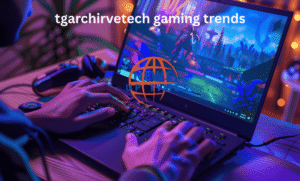Introduction to Tgarchirvetech Gaming Trends
The realm of gaming has undergone significant transformations over the years, with technological advancements playing a pivotal role in shaping player experiences and the overall industry landscape. Tgarchirvetech gaming trends represent the latest developments and patterns emerging within this dynamic sector, influencing how games are developed, marketed, and consumed. These trends are crucial, as they not only reflect the current preferences of gamers but also anticipate the future directions of gaming technology and its intersection with various cultural elements.
Historically, gaming has evolved from simple, pixelated graphics and basic mechanics to complex narratives and immersive environments powered by cutting-edge technology. The rise of high-performance consoles, virtual reality (VR), augmented reality (AR), and mobile gaming has revolutionized accessibility and engagement, fostering a diverse gaming community. As we explore tgarchirvetech gaming trends, it is vital to examine not only the technological innovations that fuel these shifts but also the socio-economic factors that drive consumer behavior.
Recent advancements such as cloud gaming, artificial intelligence, and blockchain technology are not merely trends but significant milestones that have redefined gaming experiences. These innovations enhance real-time interaction and connectivity, encourage immersive storytelling, and provide new economic models for players and developers alike. Furthermore, the growing emphasis on online multiplayer experiences and esports has catalyzed changes in player engagement and competition, establishing gaming as a viable avenue for social interaction and professional opportunities.
By understanding tgarchirvetech gaming trends, stakeholders can gain insights into the evolving preferences of gamers, enabling them to adapt their offerings to meet the demand for more personalized, engaging, and inclusive gaming environments. As we delve deeper into this article, we will uncover specific innovations and analyze consumer behavior within the gaming industry, offering a comprehensive view of where the gaming landscape is headed.
Emerging Technologies Shaping Tgarchirvetech Gaming
The gaming industry is undergoing a substantial transformation fueled by emerging technologies that redefine tgarchirvetech gaming trends. Among these innovations, Virtual Reality (VR) stands out as a pioneering force, immersing players in interactive environments that heighten engagement and realism. As major gaming companies invest heavily in VR hardware and software, titles such as “Beat Saber” and “Half-Life: Alyx” exemplify the potential of VR to provide unique, engaging experiences, ultimately reshaping player expectations.
Parallel to VR, Augmented Reality (AR) has garnered attention by blending digital elements with real-world environments. This technology enables players to interact with virtual characters or objects as they navigate their surroundings. A quintessential example of AR’s impact is the game “Pokémon Go,” which successfully integrated location-based gameplay, encouraging players to explore their communities while hunting for virtual creatures. Such applications exemplify how AR contributes to enhancing tgarchirvetech gaming trends by fostering social interaction and physical activity.
Another technological advancement making waves in the gaming sector is cloud gaming. This innovation allows players to access games without the need for high-end gaming consoles or PCs, as processing takes place on remote servers. Services like Google Stadia and NVIDIA GeForce Now illustrate the feasibility of cloud gaming, enabling users to stream graphics-intensive games on various devices. The potential for democratizing access to high-quality gaming experiences positions cloud gaming as a significant player in tgarchirvetech gaming trends.
Lastly, AI-driven game development is revolutionizing how developers create and enhance gameplay. Leveraging algorithms and machine learning, developers can generate adaptive and personalized experiences, catering to diverse player preferences. This technology not only improves game design but also optimizes player retention and engagement through tailored content delivery. As seen with games like “Left 4 Dead,” where AI adjusts gameplay based on player performance, AI is at the forefront of shaping the future of tgarchirvetech gaming.

Consumer Behavior and Engagement in Tgarchirvetech Gaming
The gaming landscape is undergoing significant transformation as consumer behavior continues to evolve in response to emerging tgarchirvetech gaming trends. One of the most notable shifts is the increasing preference for interactive and immersive experiences. Gamers now seek not only entertainment but also engagement that allows them to connect with the game on a deeper level. Technologies such as virtual reality (VR) and augmented reality (AR) are playing pivotal roles in delivering these experiences, pushing boundaries and inviting users into more personalized environments. As players become more accustomed to these innovations, developers are challenged to innovate continually to meet their expectations.
Moreover, the rise of the casual gamer has changed the demographics of the gaming community. These individuals often prefer games that can be played in shorter segments, allowing for engagement during daily life, which contrasts sharply with the traditional notions of lengthy, time-consuming gaming sessions. As a result, many developers are now designing games that are accessible and easily integrated into users’ routines. This has led to an uptick in mobile gaming, with titles that are less complex yet still provide rewarding experiences being increasingly popular.
The impact of social media on gaming communities cannot be overlooked either. Platforms like Twitch and Discord facilitate not just gameplay broadcasting but also foster communities where gamers share experiences, strategies, and feedback. This social aspect has fundamentally shifted how players interact with games and one another, emphasizing collaboration and community over solitary gameplay. Data from various studies highlights that user-generated content and community engagement significantly enhance player retention and satisfaction. Consequently, game developers are increasingly adopting community-driven development practices, incorporating player feedback into game design processes to align their products more closely with consumer desires.
The Future of Tgarchirvetech Gaming Trends
The future of tgarchirvetech gaming trends appears to be a dynamic landscape that is shaped significantly by rapid technological advancements. As game developers continue to harness the power of artificial intelligence, machine learning, and augmented reality, we can expect to see an increasing integration of these technologies within gaming environments. This integration is likely to enhance gameplay experiences, allowing for more personalized interactions and adaptive narratives that shift based on player behavior.
Furthermore, as cloud gaming gains traction, accessibility will become a pivotal factor in the evolution of tgarchirvetech gaming trends. Players will no longer be confined to specific devices, as cloud services will allow for high-quality gameplay across various platforms. This shift may also foster a more inclusive gaming community, as gamers from diverse backgrounds can connect without the limitations of hardware compatibility.
However, this evolution does not come without challenges. As technology advances, so too does the potential for cybersecurity threats. Developers will need to implement robust security measures to protect user data and maintain the integrity of gaming platforms. Additionally, there is a growing concern regarding the impact of gaming on mental health, which developers and industry stakeholders must address proactively to ensure a sustainable future.
Industry experts predict that in the next five to ten years, the fusion of virtual reality and social media elements will lead to immersive experiences that not only provide entertainment but also foster social interactions in gaming. As tgarchirvetech gaming trends continue to evolve, staying abreast of these innovations and challenges will be essential for both developers and players alike. Such foresight will guide the industry’s adaptation, ensuring it remains at the forefront of technology while prioritizing user experience and safety.












Leave a Reply